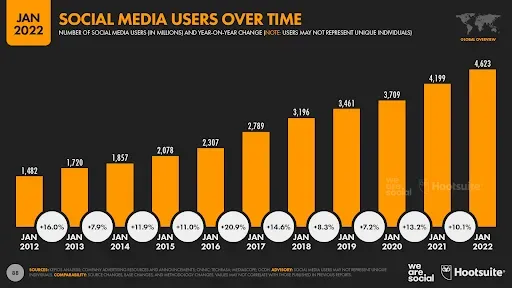The Digital 2022 report by HootSuite and We Are Social reveals that approximately 58% of the world’s entire population is comprised of social media users, showing just how prevalent the technology is.
As we move on towards further and further technological advancement, it’s astonishing to see just how virtual our lives have become. Hobbies, social interactions, jobs, grocery shopping: these are all activities that we have tied in some form or another to online experiences instead of real life ones. Now, I’m not trying to make the point that we’ve lost all touch with reality due to being online so much because I’m not a 50-year-old individual with a chip on their shoulder. All I want to do is point out the massive amount of progress that’s been made over the previous two decades. I mean, think about it: we used to still write letters back in the 90’s! It’s not like there are only children occupying these online pockets of engagement either: we’re talking about 58% of the world’s population. Gen Z’s got to be maybe 30% of that entire population, which means that social media has definitely moved on to accommodate for more diverse age groups. This isn’t your dad’s social media experience; it’s everyone’s!
What’s interesting is not just the statistic itself, but more so what it implies for the internet at large. With over half of the world online nowadays, everything else has to accommodate and set up figurative and literal shop online as well. Marketing will be an especially interesting form of trade to observe in evolution. This is for multiple reasons: the first, of course, being that marketing tactics need to really go all-out since they’re now captivating over half of the world in their antics. The second reason is the fact that there’s been a rising backlash against advertising online, with users growing tired of constant capitalistic messaging and responding with scathing tones. The Silence, Brand meme is a very relevant example of netizens ridiculing and dismissing brands at the mere instance of them appearing relatable or friendly. Seems like marketing companies have their work cut out for them, and a very unenthusiastic audience to perform for.
Meta’s having a pretty good time of the social media age, since Facebook and WhatsApp are currently the first and third most used social media platforms across the globe. The second place goes to YouTube, which tracks considering the fact that newer and newer generations of creators and streamers keep populating the site, with higher-ups happy to facilitate them in the process. Take a look at below charts for more insights:
Read next: What Do Consumers Think of the Metaverse? This Survey Has Answers
As we move on towards further and further technological advancement, it’s astonishing to see just how virtual our lives have become. Hobbies, social interactions, jobs, grocery shopping: these are all activities that we have tied in some form or another to online experiences instead of real life ones. Now, I’m not trying to make the point that we’ve lost all touch with reality due to being online so much because I’m not a 50-year-old individual with a chip on their shoulder. All I want to do is point out the massive amount of progress that’s been made over the previous two decades. I mean, think about it: we used to still write letters back in the 90’s! It’s not like there are only children occupying these online pockets of engagement either: we’re talking about 58% of the world’s population. Gen Z’s got to be maybe 30% of that entire population, which means that social media has definitely moved on to accommodate for more diverse age groups. This isn’t your dad’s social media experience; it’s everyone’s!
What’s interesting is not just the statistic itself, but more so what it implies for the internet at large. With over half of the world online nowadays, everything else has to accommodate and set up figurative and literal shop online as well. Marketing will be an especially interesting form of trade to observe in evolution. This is for multiple reasons: the first, of course, being that marketing tactics need to really go all-out since they’re now captivating over half of the world in their antics. The second reason is the fact that there’s been a rising backlash against advertising online, with users growing tired of constant capitalistic messaging and responding with scathing tones. The Silence, Brand meme is a very relevant example of netizens ridiculing and dismissing brands at the mere instance of them appearing relatable or friendly. Seems like marketing companies have their work cut out for them, and a very unenthusiastic audience to perform for.
Meta’s having a pretty good time of the social media age, since Facebook and WhatsApp are currently the first and third most used social media platforms across the globe. The second place goes to YouTube, which tracks considering the fact that newer and newer generations of creators and streamers keep populating the site, with higher-ups happy to facilitate them in the process. Take a look at below charts for more insights:
Read next: What Do Consumers Think of the Metaverse? This Survey Has Answers







